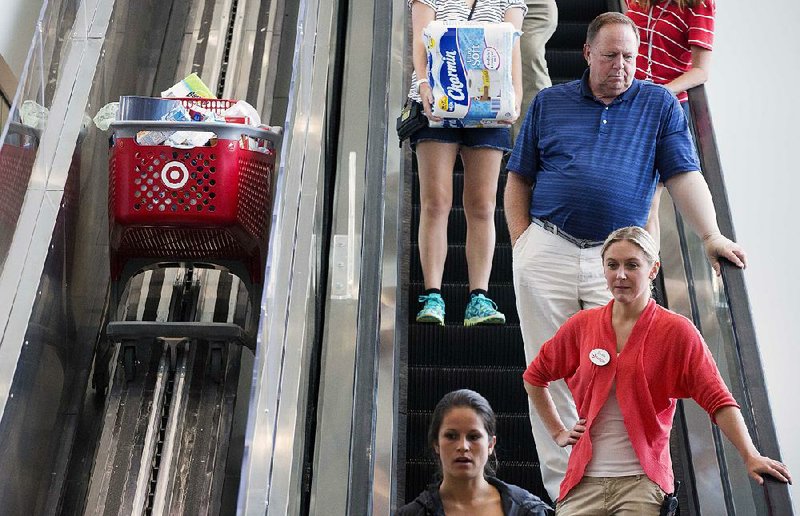WASHINGTON -- The U.S. economy expanded more than previously estimated in the second quarter, fueled by gains in consumer spending and construction.
The economy as measured by the gross domestic product -- the economy's total output of goods and services -- expanded at an annual rate of 3.9 percent in the April-June quarter, up from a previous estimate of 3.7 percent, the Commerce Department reported Friday.
The new-found strength came from additional gains in consumer spending, business investment and residential construction.
"Declining energy prices have been a big support, and that was a big windfall for consumers," said Michael Feroli, chief U.S. economist at JPMorgan Chase & Co. in New York. "We've been growing above trend, and we think that will probably continue for at least the third and fourth quarters."
The second quarter expansion was a marked improvement from a 0.6 percent increase in the first quarter when the economy was battered by a harsh winter.
While economists believe growth in the third quarter has slowed to around 2.2 percent to 2.5 percent, they expect a modest acceleration in activity for the final three months of this year.
"Overall, the outlook on the U.S. economy for the remainder of the year remains fairly optimistic, supported by continuing job creation, increasing consumer spending, improvements in the housing sector, and solid manufacturing numbers," said Jim Baird, chief investment officer for Plante Moran Financial Advisors.
The revision in second quarter growth was led by a jump in consumer spending, which expanded at a 3.6 percent rate, up from the previous estimate of a 3.1 percent advance. The stronger result reflected increases in spending on such consumer services as health care and transportation.
Business investment spending was revised higher, reflecting increased spending on structures and equipment. Residential construction grew at a 9.3 percent pace, even better than the 7.6 percent growth estimated last month.
"The consumer really had a good head of steam in the second quarter," said Chris Rupkey, chief financial economist at Union Bank in New York. "This is important and is likely to give the economy some backbone going into the financial markets turmoil and stock market gyrations in August."
Friday's report was the government's third and final estimate for second-quarter growth. The initial look tabbed GDP growth in the spring at 2.3 percent, which was revised up to 3.7 percent last month.
Economists believe the subsequent slowdown in the summer will reflect a reduction by businesses in restocking their inventories.
Once unwanted inventories are worked down, the expectation is that growth will accelerate again in the final quarter of the year. Economists at Macroeconomic Advisors are forecasting GDP growth of 2.7 percent in the October-December period.
For the whole year, economists expect a modest gain of around 2.2 percent, in line with the modest growth seen during the six years of the current recovery. In 2014, the economy grew 2.4 percent after 1.5 percent growth in 2013.
Activity has been held back this year by a rise in the value of the dollar, which weakens sales of U.S. exports while making foreign goods more competitive in the United States.
Adding to the problems facing American manufacturers has been a significant slowdown in growth in China, a major market for U.S. products.
The stronger dollar and the effect of the Chinese economy on global stock markets contributed to a decision by the Federal Reserve last week to keep its key interest rate unchanged at a record low near zero, where it has been since late 2008.
However, Fed Chairman Janet Yellen said Thursday that she still believed the Fed would start raising rates before the end of this year. While the central bank would continue to monitor developments abroad, she said that, "we do not currently anticipate that the effects of these recent developments" will be large enough to influence the Fed's interest rate decisions.
Worries about the global economy pushed American consumers' spirits to the lowest level in almost a year, the University of Michigan reported Friday.
The university's consumer sentiment index fell to 87.2 this month from 91.9 in August. The third straight monthly drop left the index with its weakest reading since October 2014.
Richard Curtin, chief economist for the survey, said consumers are disturbed by signs of trouble in the Chinese economy, the world's second-biggest, and continued economic stress in Europe.
"Consumers now believe that that global economic trends can directly influence their own job and wage prospects," he said.
Information for this article was contributed by Martin Crutsinger and Paul Wiseman of The Associated Press, by Shobhana Chandra and Chris Middleton of Bloomberg News and by Jim Puzzanghera of the Los Angeles Times.
Business on 09/26/2015
